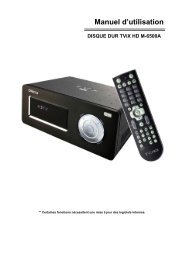MECABLITZ 50 AF-1 digital - Materiel.net
MECABLITZ 50 AF-1 digital - Materiel.net
MECABLITZ 50 AF-1 digital - Materiel.net
You also want an ePaper? Increase the reach of your titles
YUMPU automatically turns print PDFs into web optimized ePapers that Google loves.
�<br />
9 Special functions („Select“)<br />
Depending on the camera model or camera group (see Table 1), various special<br />
functions are available. For this purpose, data exchange must first occur between<br />
the flash unit and camera to access and set the special functions, for<br />
example by tapping the shutter release.<br />
☞<br />
100<br />
☛ ☛<br />
Accessing the individual special functions is achieved<br />
with the button „Select“, that is to say, the buttons —<br />
and + must be pressed simultaneously. The accompanying<br />
special functions and settings desired are then<br />
carried out individually with the button — or +.<br />
The setting must occur immediately after accessing the special functions<br />
since otherwise the flash unit automatically switches back to normal<br />
flash operation after a few seconds!<br />
9.1 Motor zoom main reflector („Zoom“)<br />
The motor zoom main reflector � of the flash unit can illuminate lens angles<br />
from 24 mm (35 mm format): Thanks to the use of the integrated wide-angle<br />
diffuser �, the illumination widens to 12 mm.<br />
Auto zoom<br />
When the flash unit is operated with a camera from Groups B, C, D or E and a<br />
lens with CPU, the zoom position of the main reflector � adjusts automatically<br />
to the lens focal length. After switching on the flash unit, „Zoom“ appears in the<br />
display and the current zoom position of the main reflector � appears.<br />
Automatic adjustment occurs for lens focal lengths from 24 mm. If a focal length<br />
of less than 24 mm is used, „24“ flashes in the display as a warning that the<br />
shot cannot be completely lit.<br />
☞ The automatic adjustment will not be activated if the main reflector is<br />
swivelled, if the wide-angle diffuser � is pulled out, or a Mecabounce<br />
(accessory) is mounted.<br />
If so desired, the position of the main reflector � can be manually adjusted in<br />
order to achieve particular lighting effects (such as spot effect etc.).<br />
Manual zoom mode<br />
In the case of cameras from Group A or when using a lens without CPU (for<br />
example, manual focus lens), the zoom position of the main reflector � must be<br />
adjusted manually to the lens focal length. In this case auto-zoom mode is not<br />
possible! After switching on the flash unit, „Zoom“ appears in the display and<br />
the current zoom position of the main reflector � appears.<br />
Setting procedure<br />
• Press button combination „Select“ until „Zoom“<br />
appears flashing next to the zoom position (mm).<br />
☛ ☛<br />
• Apply the setting desired with the buttons + and —.<br />
The flashing display changes to „M.Zoom“<br />
for manual zoom mode.<br />
M Zoom<br />
The following zoom positions are possible for<br />
the main reflector:<br />
24 - 28 - 35 - <strong>50</strong> - 70 - 85 - 105 mm<br />
(35 mm format).<br />
The setting takes effect immediately.<br />
10 m M Zoom 85 mm<br />
After about 5 seconds the display stops flashing and the setting is saved automatically.<br />
☞ When the camera transmits the lens focal length to the flash unit and a<br />
manual zoom setting results in the shot not being completely lit by the<br />
main reflector (for example, spot effect), the display of the zoom position<br />
of the main reflector flashes as a warning!<br />
☛





